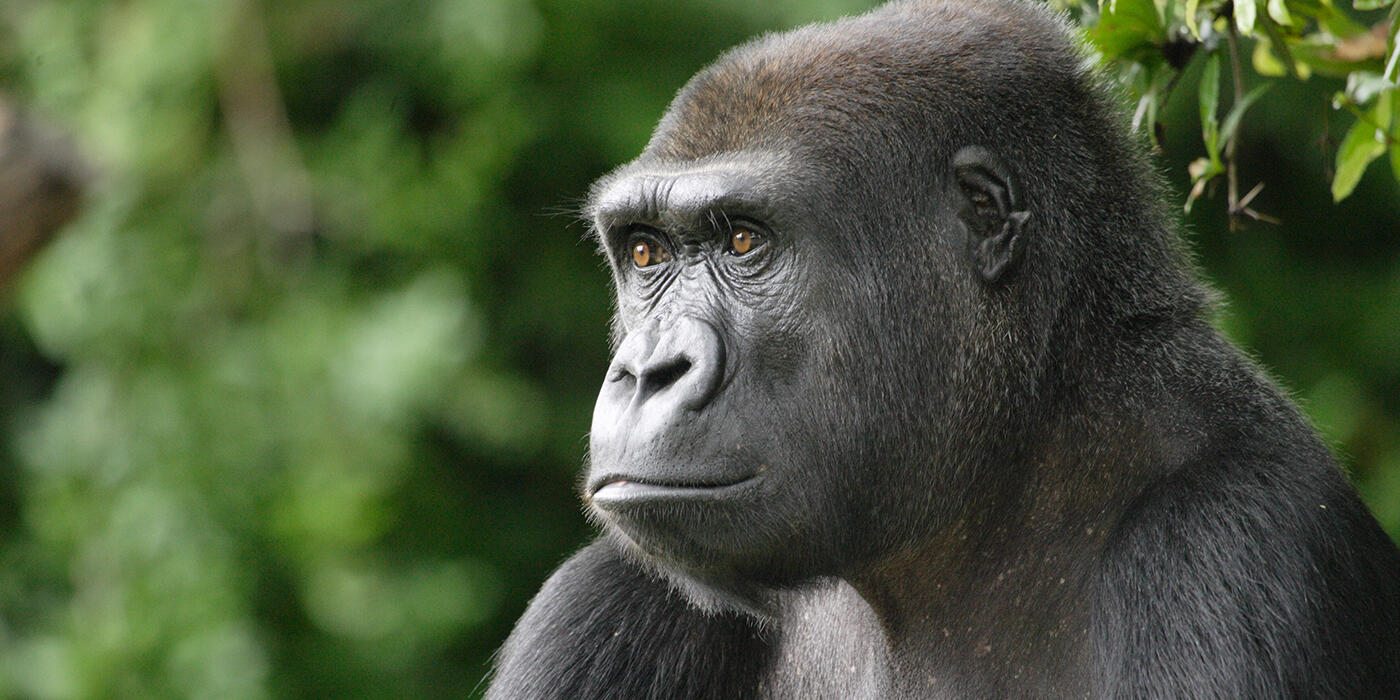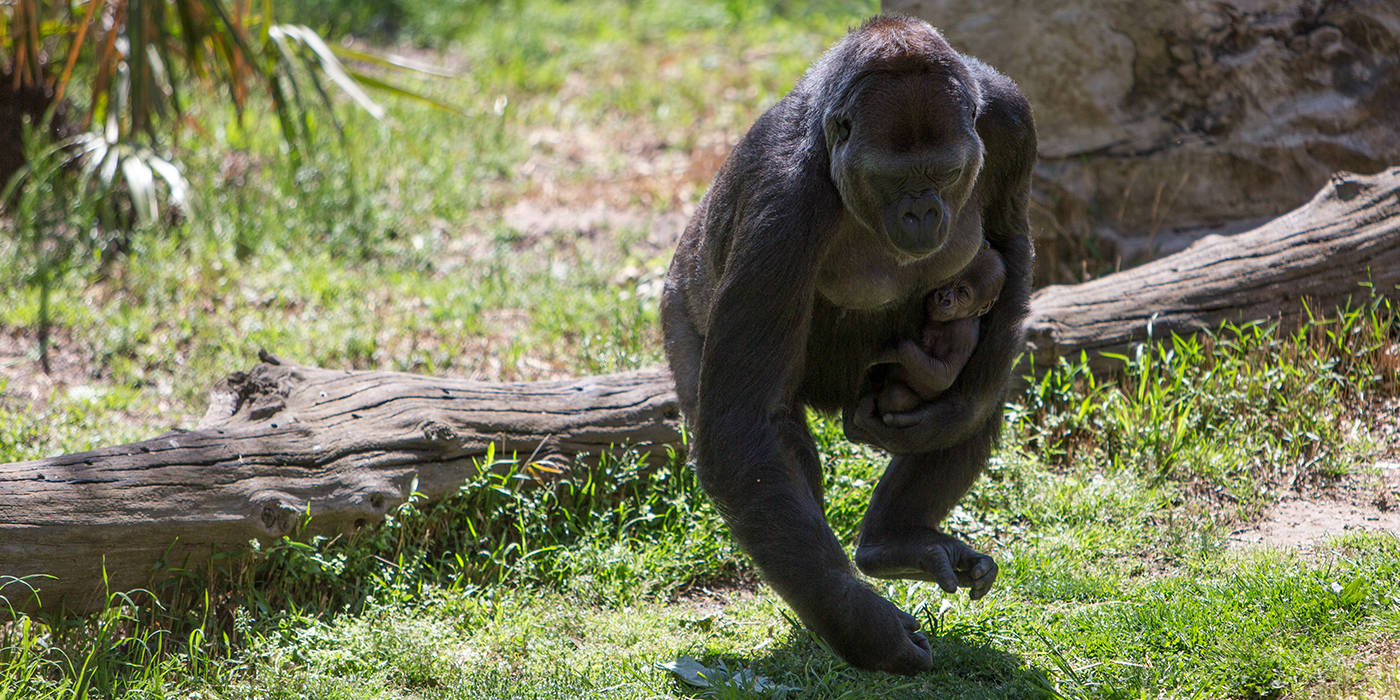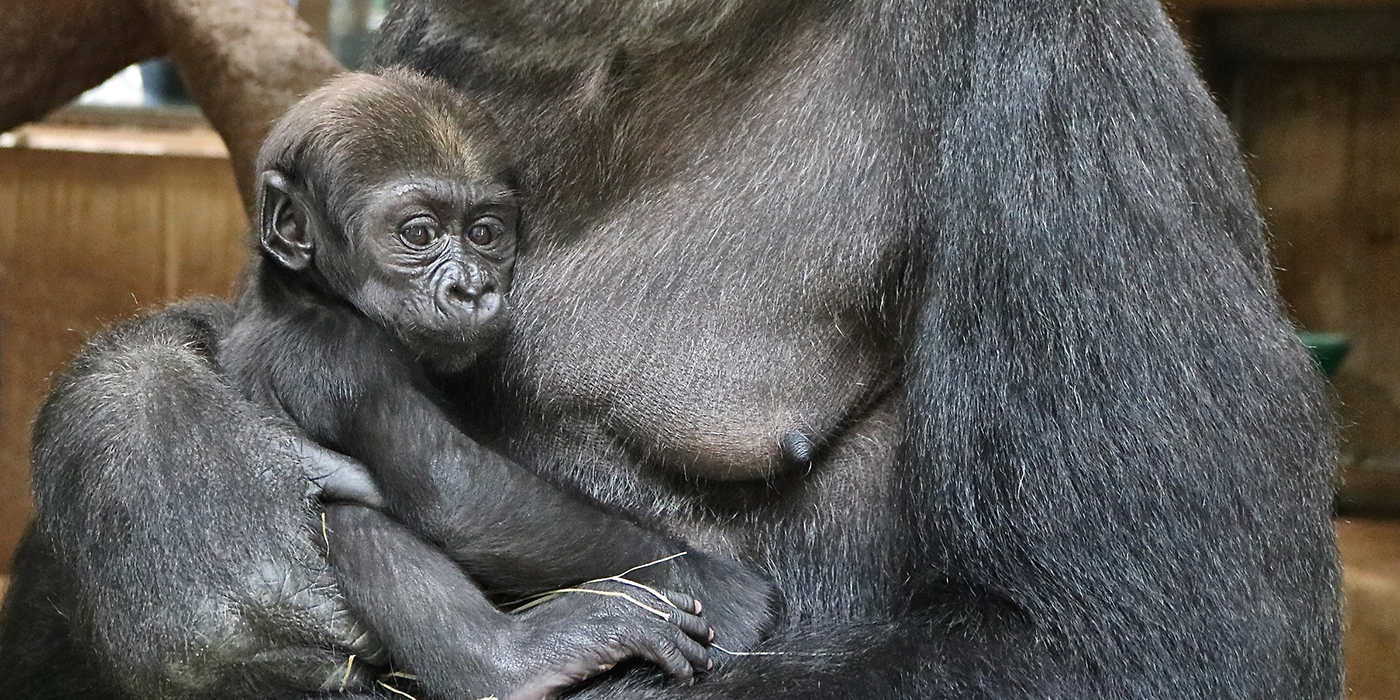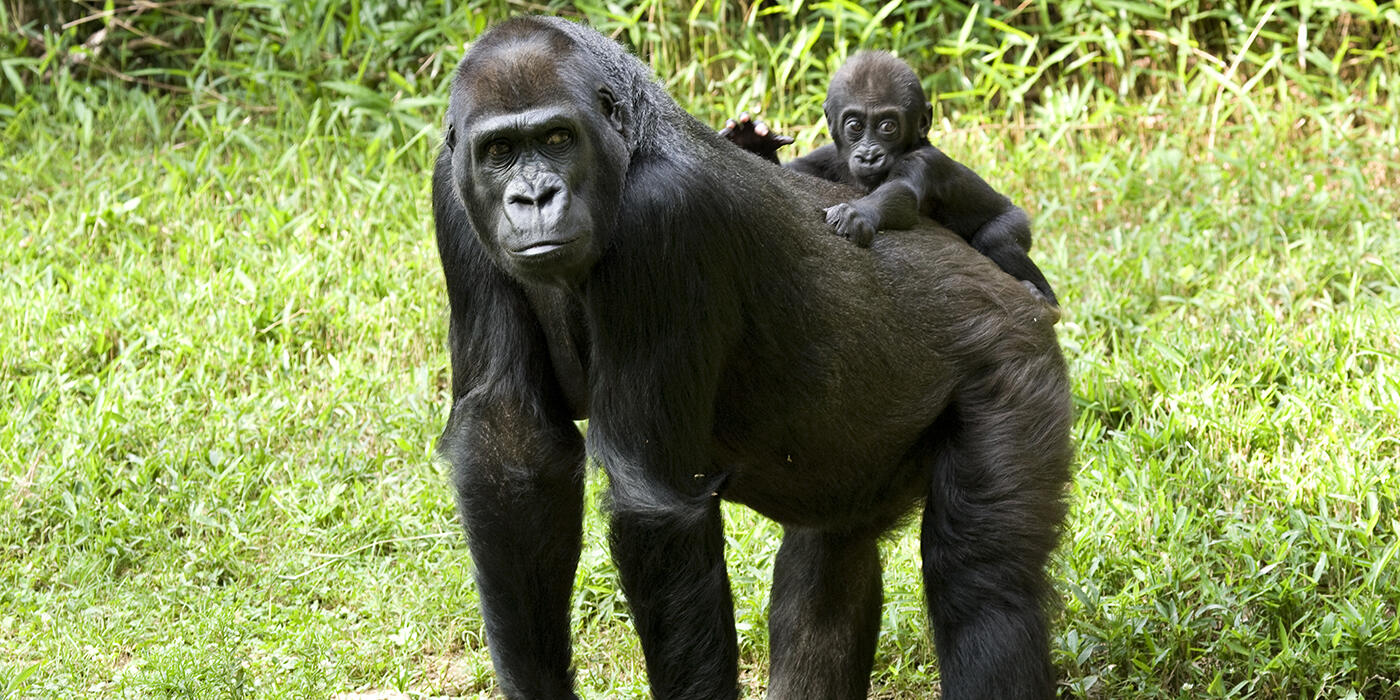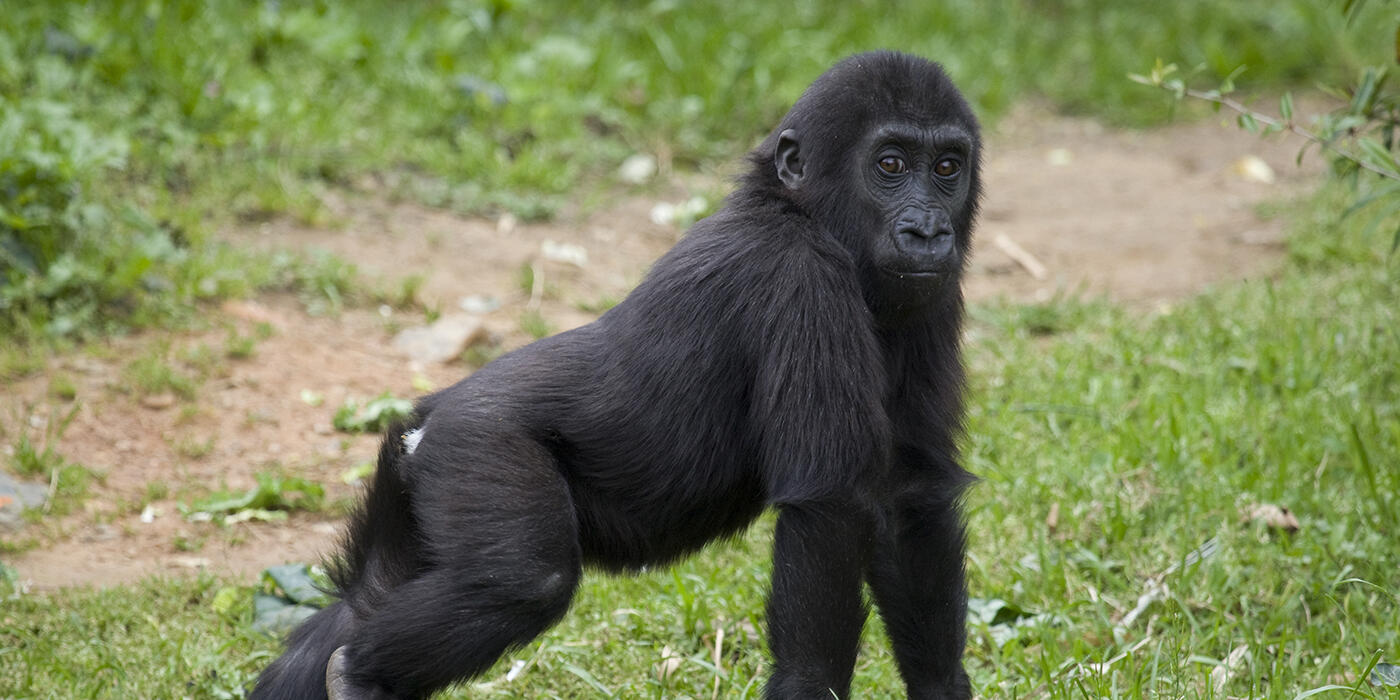Physical Description
The gorilla's coat color is black. Short, thin, gray-black to brown-black hair covers the entire body except the face. Western lowland gorillas may have a more brownish coloration. A small white tuft of hair on their rump distinguishes infants up to four years old. The white patch helps the mother keep track of the infant and assists other group members in identifying the gorilla as an infant.
Mature silverback males have a saddle of white hair across the small of their backs. In western lowland gorillas, the silver may extend to rump and thighs. Western lowland females may go gray below the ears and on the neck and top of the head as they age. Compared to other subspecies, western lowland gorillas have a more pronounced brow ridge and ears that appear small in relation to their heads. They also have a differently shaped nose and lip than other subspecies.
Adult male gorillas' heads look conical due to the large bony crests on the top and back of the skull. These crests anchor the massive muscles used to support and operate their large jaws and teeth. Adult female gorillas also have these crests, but they are much less pronounced.
In comparison to the mountain gorilla, the western lowland gorilla has a wider and larger skull, and their big toe is spread apart more from the alignment of the other four toes. Gorillas' arms are longer than their legs; when they move on all fours, they knuckle-walk, supporting their weight on the third and fourth digits of their curled hands. Like other primates, each individual has distinctive fingerprints. Gorillas also have unique nose prints.
Size
Gorillas are the largest of the great apes, but the western lowland gorilla is the smallest of the subspecies. Males are much larger than females. Adult males weigh an average of 300 pounds (136.1 kilograms) and up to 500 pounds (226.8 kilograms). They stand up to 6 feet (1.8 meters) tall.
Adult females weigh from 150 to 200 pounds (113.4 kilograms) and stand up to 4.5 feet (1.4 meters) tall. Adult males have an arm span of 8 feet (2.4 meters), and females have an arm span of 6.5 feet (2 meters).
Native Habitat
Western lowland gorillas are broadly distributed across the Congo Basin, and are more or less continuously distributed across the countries of Gabon, Central Africa Republic, Cameroon, Angola, Equatorial Guinea, and Congo.
Though present historically in the Democratic Republic of Congo, they are now likely extinct there. Western lowland gorilla ranges have been measured from 9 to 14 square miles (14.5 to 22.5 square kilometers), rarely overlapping other troops.
The average distance traveled in a day is usually less than 1 mile (1.6 kilometers), with longer distances traveled when more fruit is abundant. Because of their large size, gorillas spend most of their time on the ground.
Lifespan
In the wild, gorillas live for 30 or 40 years. In human care, gorillas may live into their 50s.
Communication
Gorillas communicate using auditory signals, visual signals and odors. They are generally quiet animals but they may also scream, bark and roar. Scientists have heard up to 22 different gorilla vocalizations, each seeming to have its own meaning.
Some examples of gorilla "body language" include crouching low and approaching from the side when being submissive; walking directly when confident and standing, slapping their chests and advancing when aggressive.
Food/Eating Habits
Gorillas are primarily herbivorous, eating the leaves and stems of herbs, shrubs and vines. They also eat the fleshy fruits of close to a hundred seasonally fruiting tree species. Other gorilla subspecies eat proportionally less fruit. Gorillas get some protein from invertebrates found on leaves and fruits. Adult male gorillas eat about 45 pounds (32 kilograms) of food per day. Females eat about two-thirds of that amount.
At the Smithsonian's National Zoo, the group is fed together in the morning. Food items are cut up and spread over a wide area. In the summer, this is usually done in the yard. In the afternoon, individuals are separated so each animal gets its share of preferred food items. Morning and evening foods include chow, greens, fruits and vegetables.
Forage items placed in hay for the gorillas include popcorn, sunflower seeds, peanuts, "enrich bits," beans and diced fruits and vegetables. Fresh tree trimmings are given daily. Some of the gorillas favorite browse; options are Bradford pear, willow, mulberry with berries and maple.
There are three feeding behaviors sometimes observed in gorillas in human care that can bother visitors. These behaviors are natural, though not to humans. They are regurgitation and reingestion, coprophagy (eating feces) and urine drinking. Regurgitation and reingestion involves an animal regurgitating some of its food and re-eating it. Biologists do not entirely understand why gorillas exhibit this behavior in human care.
A few ideas include starch or sugar content, mineral recapture or the food tasting good. Provision of forage foods, increased smaller feedings and providing browse seem to reduce this behavior in some individuals. Coprophagy is seen in the wild and is defined as the eating of feces. Gorillas do not have very efficient digestive systems for a high fiber diet, so unprocessed food can be found in their feces. Coprophagy allows an animal to utilize this food. Similarly, urine drinking might be explained as the recollection of minerals.
Sleep Habits
Gorillas are most active in the morning and late afternoon. They wake up just after sunrise to search for food and eat for several hours. At midday, adults usually nap in a day nest while the young wrestle and play games. After their midday nap, they forage again. Before dusk, each gorilla makes its own nest. Infants nest with their mothers.
Social Structure
Gorillas are flexible in their nature and behavior. Thus, the information found here is only a general guide.
Gorillas live in groups, or troops, from two to over 30 members. But data seems to indicate that western lowland gorillas live in smaller groups, averaging about five individuals. Groups are generally composed of a silverback male, one or more black back males, several adult females and their infant and juvenile offspring. This group composition varies greatly due to births, deaths and the immigration and emigration of individuals.
Mature offspring typically leave their birth group to find a mate. At about eight years old, females generally emigrate into a new group of their choosing. They seem to choose which silverback to join based on such attributes as size and quality of his home range.
A female may change family groups a number of times throughout her life. When leaving their birth group, some sexually mature males may attempt to replace the silverback in an already established group. However, they usually spend a few years as bachelor males. Nevertheless, a new troop can be easily formed when one or more non-related females join a lone male.
An adult, dominant, silverback males leads the group. He has exclusive breeding rights to the females though at times, he may allow other sub-adult males in the group to mate with females. The silverback mediates disputes and also determines the group's home range. He regulates what time they wake up, eat and go to sleep.
All gorillas over three years of age make both day nests for resting and night nests for sleeping. Infants share their mothers' nests. Gorillas form nests by sitting in one place and pulling down and tucking branches, leaves or other vegetation around themselves. Adult males usually nest on the ground. Females may nest on the ground or in trees. Juveniles are more apt to nest in trees. Studies of western lowland gorillas have shown that the number of nests found at a site does not necessarily coincide with the number of weaned animals observed in a group.
The western lowland gorilla is a quiet, peaceful and non-aggressive animal. It never attacks unless provoked. However, males do fight over females, and the new leader of a group may kill unrelated infants. This causes the females to begin cycling sooner. An adult male protecting his group may attempt to intimidate his aggressor by standing on his legs and slapping its chest with cupped or flat hands while roaring and screaming.
If this elaborate display is unsuccessful and the intruder persists, the male may rear his head back violently several times. He may also drop on all fours and charge toward the intruder. In general, when they charge they do not hit the intruder. Instead, they merely pass them by. This display of aggression maintains order among separate troops and reduces the possibility of injury. It is thought that size plays an important role in determining the winner of an encounter between males, with the larger male winning.
Gorillas exhibit complex and dynamic relationships. They interact using grooming behaviors, although less than most other primates. Affiliation may also be shown through physical proximity. Young gorillas play often and are more arboreal than the large adults. Adults, even the silverback, tolerate infant play behavior. He also tolerates and often participates in the play of older juveniles and black back males. Because of gorilla variability, some or all of these behaviors may or may not be seen.
Reproduction and Development
The duration and frequency of sexual activity in gorillas are low in comparison to other great apes. The silverback has exclusive mating rights with the adult females in his group. The reproductive success of males depends upon the maintenance of exclusive rights to adult females. The female chooses to mate with the silverback by emigrating into his family group. Normally quiet animals, some gorillas are notably loud during copulation.
There is no set time of year for gorilla births. Western lowland gorilla gestation lasts about eight and a half months. Birth occurs in a supine position over the course of a few minutes to several hours. The offspring are not born helpless. They have an instinctive grasp behavior seen in other primates allowing them to hold on to their mothers' chests.
Mothers can be seen supporting the infants for the first few months of life. Birth weight averages 4 pounds (2 kilograms). For the first couple of years, gorilla infants grow at twice the rate of a human baby. They can crawl and ride on their mothers' backs at 3 months old. They may continue to ride on their mothers' backs, chests or legs until they are 3.5-4 years old.
Females become sexually mature between 6 and 9 years of age, usually having their first baby between ten and eleven years old. The estrus cycle lasts 28 to 32 days. Ovulation is a two to three day period during which copulation occurs. While ovulating, the female signals her receptiveness to the male by her closer physical proximity to him, eye contact or staring, or displaying her rear end.
The interbirth interval is usually four and a half years. A female may have between three and six offspring in her lifetime. She is reproductive throughout her lifetime and does not experience menopause. As females become sexually mature, they transfer family groups or join lone males.
So-called "black back" males are generally eight to 12 years of age and sexually mature but not yet physically full-grown. Black backs also leave their birth family, but instead of entering a new family group, they can live alone or in all male groups until a young female chooses one of them to start a family. A black back may also challenge a silverback for an established territory and family group. At times, the heir apparent may stay in his birth family group. Silverback males are full adults at about 13 years of age or older.
Conservation Efforts
Western gorillas are a critically endangered species. They have been plagued by exceptionally high levels of disease and hunting, which has resulted in a population decline of over sixty percent in the past 20 to 25 years.
In 2007, IUCN's status for western gorillas was changed from endangered to critically endangered. This change occurred when it was discovered that one of two subspecies, the western lowland gorilla, had been devastated by the commercial bushmeat trade, the Ebola virus and the spread of logging, which alters forest structure and facilitates poaching.
Their population has declined by more than 60 percent over the last 20 to 25 years, with about one-third of the total population found in protected areas affected by the Ebola virus in the last 15 years. Cross River gorillas are also subject to hunting and habitat loss due to forest conversion, and their current population is small and fragmented.
A 2018 study estimates that more than 360,000 gorillas still inhabit the forests of Western Equatorial Africa, but 80 percent of those gorillas live outside of protected habitat.
Help this Species
Support organizations like the Smithsonian’s National Zoo and Conservation Biology Institute that research better ways to protect and care for this animal and other endangered species. Consider donating your time, money or goods.
Share the story of this animal with others. Simply raising awareness about this species can contribute to its overall protection.
Are you a student? Did you love what you learned about this animal? Make it the topic of your next school project, or start a conservation club at your school. You'll learn even more and share the importance of saving species with classmates and teachers, too.
Meet the Animals
The Zoo is home to six western lowland gorillas that reside at the Great Ape House:
- Baraka is an adult male, or silverback, who resides in the gorilla troop with Mandara, Calaya, Kibibi, Zahra and Moke. He is the largest member of our gorilla troop, weighing-in at more than 400 pounds. Baraka has a large crest on his head and a saddle of silver hair covering his back. He was born at the Smithsonian’s National Zoo in April 1992, and spent about two years living at Henry Doorly Zoo in Omaha, Nebraska, during his mid-teens. In Omaha, he sired one offspring that did not survive. Baraka has sired one offspring, Moke, here in Washington, D.C.
- Mandara is an adult female who resides in the gorilla troop. She earned the nickname “Super Mom” due to having six offspring: Kejana, Kigali, Ktembe, Kwame, Kojo and Kibibi. She raised Baraka as her own offspring shortly after his birth. Mandara was born at the Lincoln Park Zoo in April 1982 and came to the Smithsonian’s National Zoo in October 1985.
- Calaya is an adult female who resides in the gorilla troop. She is very socially savvy with the other gorilla members. Calaya was born in August 2002 at the Woodland Park Zoo and arrived at the Smithsonian’s National Zoo in February 2015 on a breeding recommendation from the Gorilla Species Survival Plan.
- Kibibi is an adult female who resides in the gorilla troop. She is full of energy and often plays with the other members of her troop. Kibibi is eager to participate in training and regularly seeks out play sessions with Moke. She was born at the Smithsonian’s National Zoo in January 2009.
- Moke is a juvenile male who resides in the gorilla troop. He was born at the Smithsonian’s National Zoo on April 15, 2018, to mother Calaya and father Baraka per a breeding recommendation from the Association of Zoos and Aquariums’ Species Survival Plan.
- Zahra is a juvenile female who was born at the Smithsonian’s National Zoo on May 27, 2023 to mother Calaya and father Baraka. Like her older brother, Moke, her parents were matched based a breeding recommendation from the Association of Zoos and Aquariums’ Species Survival Plan.
Based on recommendations from the Gorilla Species Survival Plan, the zoo manages one mixed-sex gorilla troop. The troop alternate indoor and outdoor space, depending on the time of day and the weather.
Smithsonian's National Zoo and Conservation Biology Institute. (n.d.). Western lowland gorilla. Retrieved December 2, 2025, from https://nationalzoo.si.edu/animals/western-lowland-gorilla
Animal News

Giant Panda Qing Bao Gets a Checkup ›

7 Spooktacular Animal Facts for Halloween ›

